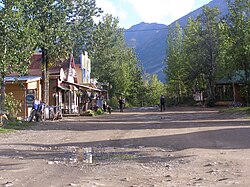What Happen ? How in the world did we get to Valdez? Aug 3rd 2023
First - The Photo above was taken Aug 15, 2015. With my Canon. However, the person taking the photo was a Professional Photog. In those few minutes amazing what he taught. More Later on Worthington Glacier.
Well, this has been an exciting journey, so far. How did we end up in Valdez without posting anything ?
To tell you the truth, I just plain forgot how to write.
To begin with, we left Homer on July 25, and headed back north. Along the way, we stopped in at the 3 Bears Fuel Station, took on Diesel along with Propane. Once done we continued onto a dry camping spot next to a lake called Petersen Lake. Remember on the way down, we stopped and overnight at her sister lake, Kelly. We hooked up with Linda, Jeff Venable along with Tom and Sue Rogers.
We enjoyed the quietness of the lake, along with the sightings on the Loons.
History[edit]

For centuries, Athabascans hunted in the area of McCarthy. Chief Nikolai and his band of Athabaskan Natives had a summer camp at Dan Creek, 15 miles east of McCarthy, where they collected copper nuggets from Dan Creek. Their permanent camp was on the Copper River at the village of Taral near Chitina where they fished for salmon.
Copper was discovered between the Kennicott Glacier and McCarthy Creek in 1900, after which Kennicott Mine, Kennecott Mining Company, and company town of Kennecott were created. Due to a clerical error, the corporation and town used the spelling of Kennecott instead of Kennicott, named for Kennicott Glacier in the valley below the town. The glacier was named after Robert Kennicott, a naturalist who explored in Alaska in the mid-1800s.
Partly because alcoholic beverages and prostitution were forbidden in Kennecott, McCarthy grew as an area to provide illicit services not available in the company town. It grew quickly into a major town with a gymnasium, a hospital, a school, a bar and a brothel. The Copper River and Northwestern Railway reached McCarthy in 1911.

In 1938, the copper deposits were mostly gone and the town was mostly abandoned. The railroad discontinued service that year. Over its 30-year operation, U.S. $200 million in ore was extracted from the mine, making it the richest concentration of copper ore in the world.
The population of McCarthy and Kennecott fell to almost zero until the 1970s, when the area began to draw young people from the many who came to Alaska in the '70s for adventure and the big money of the Trans Alaska Pipeline project. In the '80s, after the area was designated Wrangell-St. Elias National Park (1980), it began to draw some adventurous tourists to the new national park. The few people that lived there began to provide a variety of tourist services. There has always been at least one family living in the McCarthy area since 1953.
The old mine buildings, artifacts, and colorful history attract visitors during the summer months. The Kennecott and McCarthy area ranks as one of the United States' most endangered landmarks by the National Trust for Historic Places. Emergency stabilization of the old buildings has been done and more will be required.
In 2014, the TV show Edge of Alaska premiered on Discovery Channel.[11] The show has caused controversy though, as many town residents feel the town is portrayed in a bad light due to the troublesome incidents that have occurred there.
1983 shooting[edit]
In an attempt to disrupt the Alaska pipeline,[12] 39-year-old Louis D. Hastings, armed with a .223-caliber Ruger Mini-14 semi-automatic rifle,[13] murdered six of the 22 citizens of McCarthy on March 1, 1983. The victims were Maxine Edwards, Harley King, Les and Flo Hegland, Tim Nash and Amy Lou Ashenden Nash.[12] He also wounded two people. In July 1984, Hastings was sentenced to 634 years in prison.[14]





















Another great write up Dale. Makes us hungry for adventure! Thanks for sharing!
ReplyDelete